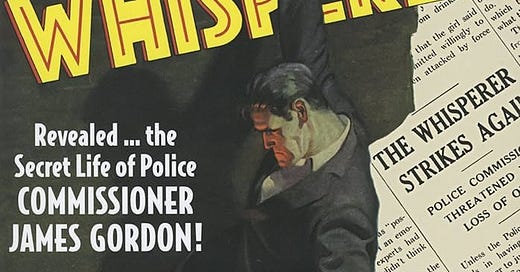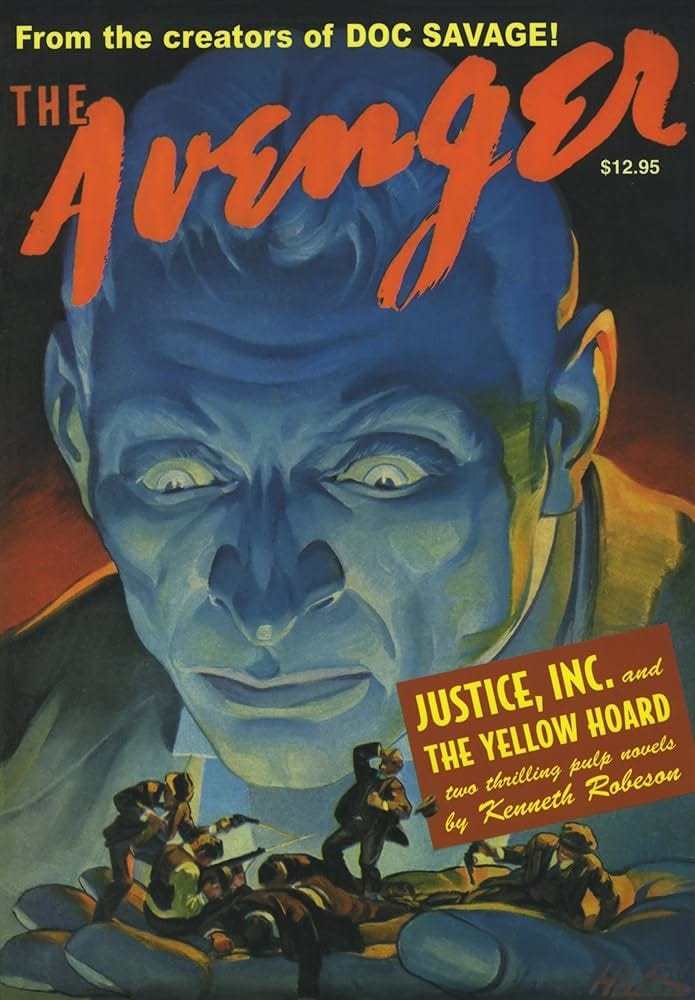The Whisperer vs. The Avenger
Who will stand alongside Doc Savage and The Shadow in the hero pulp pantheon?
Out of the foggy night steps a ghostly figure in gray -- The Whisperer! His super-silenced automatics spitting blue flame, he hurls a hissing challenge to the Law and lawless alike! And hot on his crooked trail, legendary lawman Wildcat Gordon!
In "The Six Pyramids of Death", Commissioner James "Wildcat" Gordon starts sneaking around a countess's house in the guise of The Whisperer, a vigilante in the same ominous mode as The Shadow. While searching for evidence that would convict the countess, The Whisperer gets mired in a net of bad luck--and frequent blows to the back of his head. For when he wakes up, he observes a secret meeting as cutthroats argue over six golden pyramids. But as the pyramids start disappearing, the cutthroats start dying. While The Whisperer is caught in a web of death, Commissioner Gordon must also fen off the machinations of his hostile mayor.
Billed as the most violent series Street & Smith ever published, The Whisperer wears its homage to The Shadow on its sleeve. Everything in that classic formula is present, from the ominous atmosphere to the brooding in the shadows, a radio-friendly calling card, and the twin automatics. Even the cadence of the story matches The Shadow, including the refrain of "For the man watching from the hiding place was The Whisperer." Unfortunately, when assembling that classic formula, something broke along the way, as the sum is decidedly less than the parts.
Wildcat Gordon turns into The Whisperer through the addition of dental plates that build out his jaw. The catch is, they also affect his voice, reducing it to the whisper that gives his alter-ego his name. A novel solution to the quandary facing any vigilante trying to hide his identity--and one more convincing than the Moon Man's--but it undermines the ominous mystery of The Whisperer with weakness. Worse still, The Whisperer gets knocked out on a regular basis in this story. While it gives Gordon personal stakes in bringing the criminals to justice--or a grave, for the murderers--With how many times someone has snuck up on and decked the Whisperer, it's a wonder he still has a secret identity...or a life.
On top of that, the mood whiplash continues, replacing the dark, brooding ominous man of shadows with the folksy, good old boy commissioner. Knowing too much about the man behind the mask does undermine the story. Why not a folksy good old boy? Because, at least in fiction, most good old boys settle matters directly, without all the theatrics and sophistication a man of the shadows must use. But what is believable is the violence.
As for six pyramids of death, which have been an afterthought not just in this review, but in the story, a more classic example of a MacGuffin will be hard to find. There's no mystery here, just a lure to get the gunmen shooting at each other, and the reason for their existence is a disappointing capstone to such a violent treasure hunt.
For writers, the prose of The Whisperer is an object lesson. As Lester Dent says, wave those tags. Not only does it give readers quirks that identify characters, but they also allow writers to use more than full names and pronouns to refer to their characters. This is especially helpful in action scenes, where the constant usage of a character's full name brings The Whisperer's fights too close to the dreaded checklist.
The sum total is that in "The Six Pyramids of Death", The Whisperer misses the mark of the hero pulps. As such, he is more notable as being one of the many inspirations swept up into the plagiaristic Batman than for his own adventures.
"In the roaring heart of the crucible, steel is made. In the raging flame of tragedy, men are forged into something more than human.
"Crime's greed turned the retired adventurer, Richard Henry Benson, into--
"The Avenger."
Some men are, like Doc Savage, raised from birth to fight crime. Others, like the Shadow, just want to watch the underworld burn. Benson, however, was made at the very moment when his wife and daughter vanished mid-flight from the seats next to his. Everyone thinks Benson is insane, with a brain flu that tells him he has family not his own. But cracks form in that gaslighting when a cabbie tells Benson that he remembers Benson together with his family. Suddenly, Benson, now a man of steel and gray, leaps into action. During his treatment in the sanitorium, Benson's face was paralyzed and his complexion reduced to a ghostly pallor. Clad in gray, he looks more like a gun waiting to fire than a man. And his first taste of vengeance is three toughs trying to silence his investigations. Benson subdues the men for the police, who release the criminals hours later. But the encounter was worthwhile, for it leads him to Fergus MacMurdie, who wants to help Benson.
MacMurdie has a special hate for mobsters, who killed his family in an insurance-racket bombing. MacMurdie recognizes a kindred spirit, and, even better for Benson, he knows that more people have vanished during similar routine flights on the same flight path. The two men decide to work together to investigate. There's just one rule:
No Police.
Their first investigation reveals the plane and the trapdoor used to get Benson's wife and daughter off the plane. But the mechanics capture Benson. Thanks to a disguise, the crooks think Benson is a detective, and not himself. Benson escapes after they attempt to murder him. He discovers another scheme by the same gang against a millionaire. The rich man is disappeared, but not before Benson picks up another ally: Smitty, an MIT engineer fallen on hard times. With that, the core for what will become Justice, Inc. is assembled. Benson and companions finally trace the operation to an island in the Great Lakes in a bit of a running rollercoaster of action sequences. While there, they break up the gang, rescue the millionaire, and discover the motive and method for the sky disappearances. But Benson's family is nowhere to be found. Fueled by the faintest of hopes and a burning desire to stamp out the kinds of men who robbed him of his family, Benson sets up shop with his companions in New York and becomes--
The Avenger!
The Avenger succeeds at being the third of a power trio of heroes where The Whisperer failed in that, while both are inspired by Doc and The Shadow, The Avenger is not copying either the way the Whisperer did. The personal stakes are also higher and relatable in The Avenger, and, while Benson does take a few lumps in the course of learning his new trade, he isn't getting jobbed out to every henchman, so he stays strong in the readers' eyes, unlike Wildcat Gordon. And, those few lumps Benson gets, he immediately gets payback for, as well.
The difference comes down to relatability, and what fosters it. The Avenger shows that common experience, that of the sorrow of losing a loved one, matters more than looking like the audience, the way The Whisperer's Wildcat Gordon and his folksiness attempted to.
The Avenger was born out of a need to fill the demand for more Doc Savage and Shadow stories. Try as Dent and Gibson might, two stories a month was about the limit of the production pipeline. So a third hero pulp was created, with significant input from Dent and Gibson. The two-fisted action and the aversion to murder are straight from Doc Savage, while the imposing visage and penchant for misdirection and disguise are from the Shadow. But it's pulp veteran Paul Ernst that makes Benson's quest for his family a real page-turner.Successful in weird fiction, detective fiction, science fiction and more, Ernst concentrates on telling a compelling story without feeling the need to copy Dent or Gibson's word choice and style. The familiar tag waving of Dent and Gibson's refrain of...The Shadow! aren't here. As such, The Avenger is a solid introduction to the hero pulps, especially for those current-day readers unused to the heavier styles of the Man of Bronze or the Knight of Darkness.




